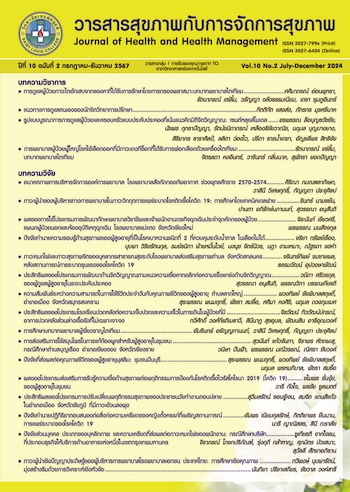Effectiveness of Back School Programs on Pain and Gait Speed in Patients with Chronic Non-specific Low Back Pain
Keywords:
Nonspecific Low Back Pain, Back School Program, Numerical Rating Scale (NRS), Maximal 10-Meter Gait SpeedAbstract
This study was designed as a randomized controlled trial with control group to study the effectiveness of Back School programs on pain and gait speed in patients with chronic nonspecific low back pain. In 60 patients with Non-specific low back pain (12 males 48 female, mean age 57.60±6.86 yr., BMI 22.27±2.61 kg/m2), 30 randomized subjects, the control group received standard treatment. The experimental group participated in 2 training activities with a Back School program manual and program compliance record form. Data were collected 2 times (At baseline and 2 months). The tools for data collection were the Numerical Rating Scale (NRS) and Maximal 10-Meter Gait Speed (10-MGS). In this study, paired t-test statistics were used to test within the experimental and control groups, and independent t-test statistics were used to test between the experimental and control groups at 2 months. It was found that subjects of the experimental group had improvement on mean NRS and 10-MGS significantly (p<.001). The control group had improved on mean NRS significantly (p<.001), But the average Maximal 10-Meter Gait Speed (10-MGS) of the experimental group was better than the control group. Conclusion: The Back School program is effective in reducing pain and improve gait speed. This school program can be applied to the context of a community hospital or Sub-District Health Promoting Hospital with similar contexts
References
กวีวัจน์ จักสมศักดิ์ และประสาร มาลากุล ณ อยุธยา. (2565). ผลของโปรแกรมการสอนการปรับโครงสร้างและท่าทางที่ผิดปกติโดยใช้การปรับพฤติกรรมทางปัญญาด้วยเทคนิคการแก้ปัญหาต่อคุณภาพชีวิตของผู้ป่วยปวดหลังส่วนล่าง. วารสารวิชาการสมาคมสถาบันอุดมศึกษาเอกชนแห่งประเทศไทย (สสอท.), 28(1), 31-46.
จิรวัฒน์ ทิววัฒน์ปกรณ์, ทวีศักดิ์ วงศ์กีรติเมธาวี, และ สินีนาฎ สุขอุบล. (2565). การพัฒนาและประสิทธิผลของโปรแกรมโรงเรียนปวดหลังหาดใหญ่ในผู้ป่วยที่มีอาการปวดหลังส่วนล่างเรื้อรัง. วารสารกายภาพบำบัด, 44(1), 29-46.
พัชรินทร์ น้อยสุวรรณ, วีระพร ศุทธากรณ์, และวันเพ็ญ ทรงคำ. (2562). ผลของโปรแกรมโรงเรียนปวดหลังต่ออาการปวดหลังส่วนล่างและความสามารถในการปฏิบัติหน้าที่ของเกษตรกรชาวนา. พยาบาลสาร, 46(3), 142-156.
Ampiah, J. A., Moffatt, F., Diver, C., & Ampiah, P. K. (2022). Understanding how patients’ pain beliefs influence chronic low back pain management in Ghana: a grounded theory approach. BMJ open, 12(12). doi: 10.1136/bmjopen-2022-061062
Bardin, L. D., King, P., & Maher, C. G. (2017). Diagnostic triage for low back pain: a practical approach for primary care. Medical journal of Australia, 206(6), 268-273.
Chiarotto, A., & Koes, B. W. (2022). Nonspecific low back pain. New England Journal of Medicine, 386(18), 1732-1740.
Du, S., Hu, L., Bai, Y., Dong, J., Jin, S., Zhang, H., & Zhu, Y. (2018). The influence of self-efficacy, fear-avoidance belief, and coping styles on quality of life for Chinese patients with chronic nonspecific low back pain: A multisite cross-sectional study. Pain Practice, 18(6), 736-747.
Ebrahimi, S., Kamali, F., Razeghi, M., & Haghpanah, S. A. (2017). Comparison of the trunk-pelvis and lower extremities sagittal plane inter-segmental coordination and variability during walking in persons with and without chronic low back pain. Human movement science, 52, 55-66.
Maher, C., Underwood, M., & Buchbinder, R. (2017). Non-specific low back pain. The Lancet, 389(10070), 736-747. doi: 10.1016/S0140-6736(16)30970-9
Müller, R., Ertelt, T., & Blickhan, R. (2015). Low back pain affects trunk as well as lower limb movements during walking and running. Journal of biomechanics, 48(6), 1009-1014.
Oliveira, C. B., Maher, C. G., Pinto, R. Z., Traeger, A. C., Lin, C. W. C., Chenot, J. F., ... & Koes, B. W. (2018). Clinical practice guidelines for the management of non-specific low back pain in primary care: an updated overview. European Spine Journal, 27(11), 2791-2803. doi: 10.1007/s00586-018-5673-2
Rahimi, A., Arab, A. M., Nourbakhsh, M. R., Hosseini, S. M., & Forghany, S. (2020). Lower limb kinematics in individuals with chronic low back pain during walking. Journal of Electromyography and Kinesiology, 51, 102404. doi: 10.1016/j.jelekin.2020.102404
Sahin, N., Albayrak, I., Durmus, B., & Ugurlu, H. (2011). Effectiveness of back school for treatment of pain and functional disability in patients with chronic low back pain: a randomized controlled trial. Journal of rehabilitation medicine, 43(3), 224-229.
Van Dieën, J. H., Reeves, N. P., Kawchuk, G., Van Dillen, L. R., & Hodges, P. W. (2019). Motor control changes in low back pain: divergence in presentations and mechanisms. Journal of Orthopaedic & Sports Physical Therapy, 49(6), 370-379.
Downloads
Published
How to Cite
Issue
Section
License
Copyright (c) 2024 Journal of health and health management

This work is licensed under a Creative Commons Attribution-NonCommercial-NoDerivatives 4.0 International License.




